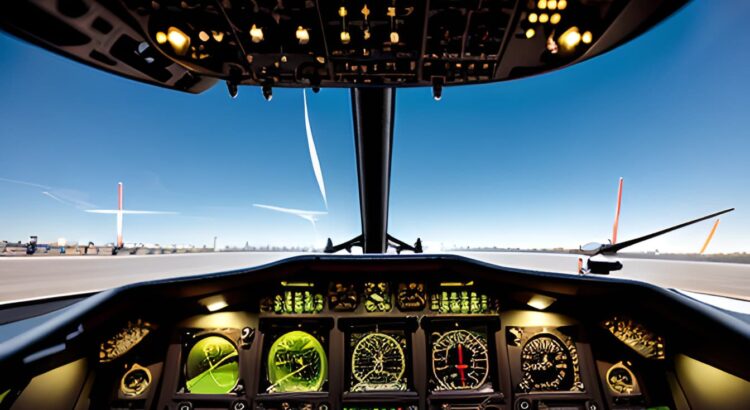Pilots require optimal vision to ensure safe flights. The FAA has stringent vision standards, encompassing visual acuity, peripheral vision, and color vision. Astigmatism, a common vision issue, can compromise clarity. Uncorrected astigmatism affects gauge reading and object identification. This article delves into the FAA’s vision requirements for pilots and examines whether can you fly after LASIK while meeting these standards
Astigmatism and Vision
Astigmatism is a common vision condition caused by an irregular curvature of the cornea or lens in the eye. This leads to blurred or distorted vision, as light is focused imperfectly on the retina. Mild astigmatism may only cause slightly blurred vision at certain distances, while severe astigmatism can significantly impact vision clarity. About 30-60% of people have some degree of astigmatism. The good news is that astigmatism can often be corrected with prescription eyeglasses or contact lenses specifically designed to compensate for the corneal irregularity. Refractive surgery like LASIK can also correct astigmatism by reshaping the cornea with a laser. If you’re wondering how long it takes to recover from LASIK, it takes around 4-6 weeks to fully recover vision after the procedure. With proper correction, most people with astigmatism can achieve 20/20 vision for daily activities.
FAA Vision Requirements for Pilots
To receive any class of FAA medical certification required for piloting, applicants must pass an extensive aviation medical exam that thoroughly tests vision. There are three classes of FAA medical certificates. First class is required for airline transport pilots, second class for commercial pilots, and third class for student and recreational pilots. Regardless of certificate type, the FAA vision standards are strict. Distant visual acuity must be 20/20 or better in each eye separately, corrected or uncorrected. Near vision must be 20/40 or better when corrected. Peripheral vision must be at least 70 degrees horizontal meridian in each eye. Normal binocular function is required, along with the ability to distinguish red, green, and white aviation signals.
Certain conditions are disqualifying, like double vision, severe night blindness, and severe astigmatism exceeding +2.00 diopters. The FAA does not allow monovision correction, where each eye is corrected differently for near/far vision. Corrective lenses are permitted, but the best correctable vision must be 20/20 in each eye for all classes of medical certificates. If an individual s uncorrected vision doesn t meet standards, the FAA may still issue medical certification if the vision can be corrected to 20/20 with refractive surgery, contact lenses or glasses. Meeting the FAA vision requirements is essential to being medically certified and able to pursue a career as an airline pilot.
Options for Meeting Standards with Astigmatism
For aspiring pilots with uncorrected astigmatism, there are options for correction of astigmatism to meet FAA requirements. Prescription eyeglasses or contact lenses can be tailored specifically to compensate for astigmatism and optimize visual acuity. According to experts, “Properly prescribed astigmatism correction in glasses or contacts can make a big difference in focusing light accurately on the retina.” Refractive surgery like LASIK or PRK can also treat astigmatism by reshaping the cornea. One pilot said, “Having LASIK to correct my astigmatism was the best decision. I now have 20/15 vision uncorrected.” The FAA does not permit monovision correction using contacts, where each eye is optimized differently. Both eyes must correct to 20/20. While astigmatism can pose challenges, many pilots find solutions. For example, one regional airline captain with astigmatism says “With my custom contact lens prescription, I see clearly in the cockpit and pass my medical exams with no problem.”
Tips for Pilots with Astigmatism
Pilots with astigmatism can take steps to safely manage their vision. Always have backup eyeglasses in case of lost or irritated contact lenses. Stock up on contact lens supplies to avoid running out. Work closely with your optometrist for regular exams and updated prescriptions if vision changes. When starting a new glasses or contacts prescription, wait to fly until fully adjusted. In the cockpit, be alert to any blurred vision, eyestrain, or headaches which could indicate an issue. Promptly report any worrisome astigmatism symptoms or changes in visual acuity to your aviation medical examiner. For FAA certification, continue to meet vision standards by passing required medical re-examinations. With proper management and corrected 20/20 vision, pilots with astigmatism can safely handle the visual demands of aviation. The key is working closely with eyecare providers to optimize correction.
Conclusion
In summary, astigmatism is a common vision condition that does not have to barrier one from becoming a pilot. The FAA requires best corrected visual acuity of 20/20, but this can often be achieved in those with astigmatism using well-prescribed glasses, contacts, or refractive surgery. Working closely with an eyecare provider familiar with aviation vision standards is key to finding the right solution. Proper management will allow aspiring aviators with astigmatism to meet requirements and safely take to the skies. While presenting challenges, corrected 20/20 vision will open up an exciting career in aviation.
